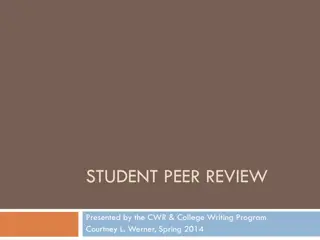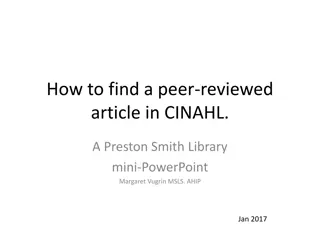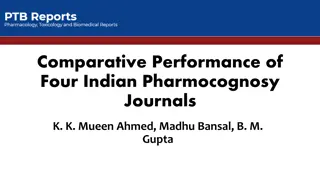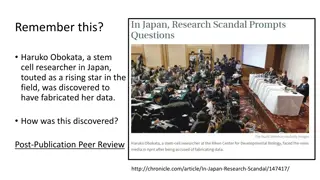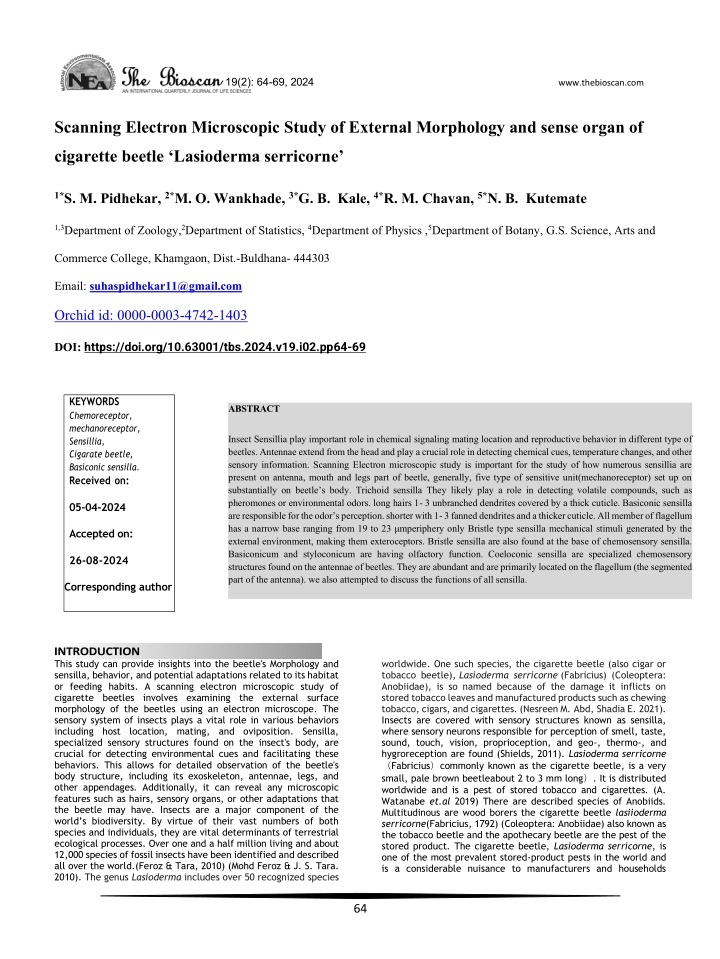
peer reviewed scientific journals
Peer-reviewed scientific journals are academic publications that feature articles which have undergone a rigorous evaluation process by experts in the field before being published. This process typically involves Submission: Authors submit their rese
Download Presentation

Please find below an Image/Link to download the presentation.
The content on the website is provided AS IS for your information and personal use only. It may not be sold, licensed, or shared on other websites without obtaining consent from the author. If you encounter any issues during the download, it is possible that the publisher has removed the file from their server.
You are allowed to download the files provided on this website for personal or commercial use, subject to the condition that they are used lawfully. All files are the property of their respective owners.
The content on the website is provided AS IS for your information and personal use only. It may not be sold, licensed, or shared on other websites without obtaining consent from the author.
E N D
Presentation Transcript
19(2): 64-69, 2024 www.thebioscan.com Scanning Electron Microscopic Study of External Morphology and sense organ of cigarette beetle Lasioderma serricorne 1*S. M. Pidhekar, 2*M. O. Wankhade, 3*G. B. Kale, 4*R. M. Chavan, 5*N. B. Kutemate 1,3Department of Zoology,2Department of Statistics, 4Department of Physics ,5Department of Botany, G.S. Science, Arts and Commerce College, Khamgaon, Dist.-Buldhana- 444303 Email: suhaspidhekar11@gmail.com Orchid id: 0000-0003-4742-1403 DOI: https://doi.org/10.63001/tbs.2024.v19.i02.pp64-69 KEYWORDS Chemoreceptor, mechanoreceptor, Sensillia, Cigarate beetle, Basiconic sensilla. Receivedon: ABSTRACT Insect Sensillia play important role in chemical signaling mating location and reproductive behavior in different type of beetles. Antennae extend from the head and play a crucial role in detecting chemical cues, temperature changes, and other sensory information. Scanning Electron microscopic study is important for the study of how numerous sensillia are present on antenna, mouth and legs part of beetle, generally, five type of sensitive unit(mechanoreceptor) set up on substantially on beetle s body. Trichoid sensilla They likely play a role in detecting volatile compounds, such as pheromones or environmental odors. long hairs 1- 3 unbranched dendrites covered by a thick cuticle. Basiconic sensilla are responsible for the odor s perception. shorter with 1- 3 fanned dendrites and a thicker cuticle. All member of flagellum has a narrow base ranging from 19 to 23 mperiphery only Bristle type sensilla mechanical stimuli generated by the external environment, making them exteroceptors. Bristle sensilla are also found at the base of chemosensory sensilla. Basiconicum and styloconicum are having olfactory function. Coeloconic sensilla are specialized chemosensory structures found on the antennae of beetles. They are abundant and are primarily located on the flagellum (the segmented part of the antenna). we also attempted to discuss the functions of all sensilla. 05-04-2024 Accepted on: 26-08-2024 Corresponding author This study can provide insights into the beetle's Morphology and sensilla, behavior, and potential adaptations related to its habitat or feeding habits. A scanning electron microscopic study of cigarette beetles involves examining the external surface morphology of the beetles using an electron microscope. The sensory system of insects plays a vital role in various behaviors including host location, mating, and oviposition. Sensilla, specialized sensory structures found on the insect's body, are crucial for detecting environmental cues and facilitating these behaviors. This allows for detailed observation of the beetle's body structure, including its exoskeleton, antennae, legs, and other appendages. Additionally, it can reveal any microscopic features such as hairs, sensory organs, or other adaptations that the beetle may have. Insects are a major component of the world s biodiversity. By virtue of their vast numbers of both species and individuals, they are vital determinants of terrestrial ecological processes. Over one and a half million living and about 12,000 species of fossil insects have been identified and described all over the world.(Feroz & Tara, 2010) (Mohd Feroz & J. S. Tara. 2010). The genus Lasioderma includes over 50 recognized species worldwide. One such species, the cigarette beetle (also cigar or tobacco beetle), Lasioderma serricorne (Fabricius) (Coleoptera: Anobiidae), is so named because of the damage it inflicts on stored tobacco leaves and manufactured products such as chewing tobacco, cigars, and cigarettes. (Nesreen M. Abd, Shadia E. 2021). Insects are covered with sensory structures known as sensilla, where sensory neurons responsible for perception of smell, taste, sound, touch, vision, proprioception, and geo-, thermo-, and hygroreception are found (Shields, 2011). Lasioderma serricorne Fabricius commonly known as the cigarette beetle, is a very small, pale brown beetleabout 2 to 3 mm long . It is distributed worldwide and is a pest of stored tobacco and cigarettes. (A. Watanabe et.al 2019) There are described species of Anobiids. Multitudinous are wood borers the cigarette beetle lasiioderma serricorne(Fabricius, 1792) (Coleoptera: Anobiidae) also known as the tobacco beetle and the apothecary beetle are the pest of the stored product. The cigarette beetle, Lasioderma serricorne, is one of the most prevalent stored-product pests in the world and is a considerable nuisance to manufacturers and households 64
alike.(Kshirsagar, 2010) Though it is not known to transmit disease or cause significant damage to products, they are capable of causing considerable financial loss through the destruction of articles such as cigars and tobaccos. (Abhijith and Mohan, 2017) cigarette beetle is a generally encountered stored product pest in the home and has long been associated with humans. (Runner, G. A. 1919). In general, anobiids are small insects with a length of 1.3 9.0 mm. The shape of their body is subcylindrical or oval (Mosneagu, 2012). Their chewing mouthparts are well developed in the grown- ups and naiads. Bills range from slender and sharp use for rapacious habits, to large and toothed, used to crush plant and beast material, or eating wood. Development in this order includes egg, naiad, nymph, and adult stages. Adult body shape is generally globular, short, rounded, and sometimes with a spiny prothorax. (Steinbrecht R. A. 1997) According to the function of the beetle antennae it bears sensilla analogous as chemoreceptors (the senses of smell olfaction and taste gustation), Mechanoreceptors, Thermo receptors and bearing sometimes sensors for CO2 (Gullan & Cranston, 2003; Hansson, 1999). The naiads of multitudinous species feed on dead wood, and some are regularly set up in woodwork and structural wood of structures. Anobiidae grown- ups are1.5 6 mm long, sanguine brown to black, and covered with fine setae or pubescence. The head is generally hidden by the pronotum, Pronotum as wide than head, vastly round to sub quadrate, borders mainly completely margined laterally. The 11- segmented antennae are fitted on the sides of the head, in front of the eyes. Antennae are mobile segmented paired accessories antenna generally has three main divisions, first member or Scape is the rudimentary stalk. Alternate member Pedicel respond to movement of the distal part of the distal part of the antenna. Distal portion of antennae called flagellum it's filamentous and multisegmented (A. Ploomi, et.,al 2003). Mesosternum suddenly, mesocoxae relatively separateed to separate by further than one coxal range, indirectly coxae closed by sternum. Nonentity mechano-sensilla generally correspond of a cuticular outfit (hair, club, and pate) beneath which a hackneyed set of cells can be set up. Insects respond widely to cues from a miscellaneous terrain, separate between hosts (both factory and beast), and respond to microclimatic factors, similar as moisture, temperature and tailwind. Senseillums descry stimulants that may be distributed as mechanical, thermal, chemical and visual. (Tilton,E.W.,et.al 1987). Generally, five type of sensitive unit(mechanoreceptor) set up on substantially on beetles body. Trichoid sensilla have long hairs 1- 3 unbranched dendrites covered by a thick cuticle. Basiconic sensilla are shorter with 1- 3 fanned dendrites and a thicker cuticle. Placoid sensilla are plate- suchlike, with 2- 50 fanned dendrites. Coeloconic sensilla have a cut- suchlike structure and are frequently located within a cuticular hole, innervated by 3- 5 unbranched dendrites. Campaniform sensilla refers to the bell shape appearance of the sensitive structure which has only a single neuron. (Olsen, A. R. (1977). nonentity mechano sensilla generally correspond of a cuticular outfit (hair, club, and pate) beneath which a hackneyed set of cells can be set up sensitive unit, abecedarian sense organ (sensillum, sensilla), they mention the types of sensisillum on nonentity s body, including Trichoid sensilla, Basiconic sensilla, Placoid sensilla, Coeloconic sensilla, and Campaniform sensilia it has been proved that chemical signals play an important role in mating location and reproductive behavior. (Gettrup, E. (1965). The use of scanning electron microscopy (SEM) can be a powerful tool in assessing the sensilla on different types of beetles. SEM is capable of providing high-resolution images that allow precise mapping and measurement of both macroscopic and microscopic structures on beetle integument surfaces due to its ability to produce images at magnifications up to several hundred thousand times. In the present study, we aimed to give morphological descriptions and distributions of colorful sensilla of L. serricorne antennae and mouthparts. Indeed, this is the first study to describe L. serricorne mouthpart sensilla and explore the morphometry of colorful sensillum types. also, we give fresh description of the antennal sensilla. Studying the sensitive structures on the antennae and mouthparts of L. serricorne will ameliorate understanding of its feeding and acclimations to colorful storehouse surroundings. likewise, our findings could be useful for developing new operation results for this pest beetle species. 2. Methods and Material Beetle was collected from the stored musk fenugreek and stored product of tobacco. Collected species of lasiioderma serricorne were collected and kept overnight in 70% of ethanol at 4 C. The samples were transferred into 80%, 90%, and 100% of ethanol for dehumidification and mounted with palladium on the microscope holders and carpeted with precaution and scrutinized by surveying electron microscope (JOEL-6380A) and snap were taken. Coating of samples is needed in the field of electron microscopy to enable or ameliorate the imaging of samples. Creating a conductive sub caste of essence on the sample inhibits charging, reduces thermal damage and improves the secondary electron signal needed for topographic examination in the Scanning electron microscope. These samples were also placed on remainders (sample holder for SEM) with the help of both side tenacious carbon tape recordings. After sheeting the samples were observed under SEM (JEOL/ EO- JSM- 6380) PC- SEM Visvesvarya National Institute of Technology (VNIT), Nagpur, Maharashtra, India. Photos were taken for relating and morphological study of its sensitive organs their length & sensilla present on the sample. 1. Result: Scanning electron microscopic studies revealed the presence of various types of sensillae on the antennae and body part of the beetle. Studies revealed the presence of various types of sensillae on the antennae and body part. Fig:A. Show Lasioderma sarricorne infects and damage to store tobacco and musk fenugreek. a. VENTRAL PORTION 65
segment about -284 m ,2nd segment 419 m, 3rd segment 135 m, 4th segment 149 m. 5th segment266 m. Figure B shows ventral portion reveled the length of head mouth part about -330 m. Length of segment present on ventral side anterior to posterior region total 5th segment shown in above figure. length of 1st SEM Study of Morphology of Antennae C. Figure: B-SEM image of Lasiodermasarricorne show Ventral view show the length of segment b. DORSAL PORTION Figure: C Show dorsal portion reveled that length of Thorax: I. Vertical length: 604 m II. Horizontal Width: 1.2 mm III. Length of the Elytra form base of the Prothorax are 1.66mm. IV. Total width of the Elytra :1.34 m. V. width of the left Elytra:664 m. VI. width of the right Elytra: 600 m. Morphological and Measurement information are revealed by SEM image of above Figure. Fig: D: Scanning Electron Micrographs showing the entire antenna of Lasiodermaserricorne, and measurement of entire antenna of Lasiodermaserricorne Antenna having serrated type (teeth like on saw of saw) and having 4 to 10 segment with widely separated Antennal insertions, distance between them more than length of first antennal segment.Antenna of tobacco beetle having bean shape scape, small pedicle and five flagella segment of antenna. Complete length of antenna is 464.3 m and having serrate structure due to triangular shape segment. The length of the segment of Antennae are as follows: 1. Antenna 2. Scape 3. Pedical 4. 1st flagellomere 5. 2nd flagellomere 6. 3rd flagellomere 7. 4th flagellomere 8. 5th flagellomere Total length of antenna D. Scanning electron micrograph of sensillae on antennae and of abdominal sensilla Length in m 63.5 m 37.1 m 64.8 m 70.9 m 84.3 m 72.9 m 70.8 m 464.3 m Antenna and abdominal region are covers by sensilla placoidea with having cuticular grooves on it. All segment of flagellum has a narrow base ranging from 19 to 23 m diameter only bristle type sensilla of various length of with sockets at their base were found on the scape, pedicel and flagella. And body. Such type sensilla are consider to be mechanoreceptive sensilla. Figure- C-SEM image of lasiodermasarricorne show dorsal view figure B & C revel that morphological structure and length of the beetles dorsal and ventral portion. 66
Fig-E Fig-F Fig: Figure (E) Scanning Electron Micrographs showing the terminal segment of male antenna, (F) abdominal sensilia. Red and yellow arrow showing cup of bristle type 1 and cup of bristle type 2 respectively. Fig:G Fig-H Fig. Scanning Electron Micrographs showing (G) Chewing and biting type of mouth parts Lasiodermaserricone. (H) Types of sensillia on found on leg and green arrow shows cuticular groove on senselliaplacoidia of abdominal region. All member of flagellum has a narrow base ranging from 19 to 23 m periphery only bristle type sensilla of colorful length of with sockets at their base were set up on the elude, pedicel and flagella. And body. similar type sensilla are consider to be mechanoreceptive sensilla. Six distinctly shaped sensilla were observed on the on body of Lasioderma serricorne and antenna. 1. SENSILLA BASICONIUM- Basiconic sensilla, identified by their cone-shaped structures with pores at the apex, were also observed on the antennae, albeit in lower numbers compared to trichoid sensilla. These sensilla likely play a role in chemoreception, aiding in the detection of volatile compounds associated with food sources and mates. Basiconic sensilla are specialized sensory structures found on the antennae and other body parts of insects. These sensilla are characterized by their cone-shaped structures with pores at the apex. Basiconic sensilla play a crucial role in chemoreception, allowing insects to detect volatile compounds in their environment. 2. SENSILLA STYLOCONICA- These are cones or pegs that sit on a spherical protuberance or style of asleep cuticle. Sensilla styloconica are have deep longitudinal grooves from the central part of tip of the shaft. These sensilla are elongated, hair- like structures with a narrow tip and a wider base embedded in the insect's cuticle. They are primarily involved in detecting chemical cues, such as pheromones or volatile compounds from the environment.These structures play crucial roles in the insect's perception of the world around them and are key to their survival and reproduction. 3. SENSILLUM CAPITULUM- This type of sensillum is girdled by a ring raised of cuticle and has an on-perforated smooth face shaft a small severance obtains near the base of shaft. They 67
are characterized by having a distinctive cup-shaped or knob-like structure at the tip. These sensilla are involved in the detection of chemical stimuli, such as pheromones or volatile compounds in the environment. 4. BRISTAL TYPE- Sensellia are set up most abundantly on the body of Lasioderma serricorne, Bristle type sensilla, also known as chaetic sensilla, are sensory structures found on the antennae, mouthparts, legs, and other parts of the body in many insects. They are characterized by their elongated, bristle-like shape. These sensilla play important roles in detecting mechanical stimuli, such as touch and vibrations, as well as sometimes serving as proprioceptors to provide feedback on the position of the insect's body parts. There are three type of Bristle type sensillia. I. Bristle type I- hair type I sensilla is a prominent because the long shaft with a slightly grooved face. The shaft without a full severance system is insert in the flexible cuticular socket. There's a terminal core opening at the tip of sensillum. II. Bristle Type II- This type of sensillum is the most extensively distributed on the beetles body. The shaft is set in a socket and tapers to a point. They've no pores on its face of tip. Bristle type II is distributed throughout parts but is rare in their distal region. III. Bristle type III- This type of sensillum is abundant on the side area of the womanish parts. The length is varying rudimentary socket are absent. No severance system can be observed on the smooth face of the shaft or tip. 5. Coeloconic sensilla- have a cut- suchlike structure and are frequently located within a cuticular hole, innervated by 3- 5 unbranched dendrites. coeloconic sensilla are essential components of an insect's chemosensory system, enabling them to perceive and respond to chemical cues critical for various behaviors, including finding food, locating mates, and avoiding predators. 6. Sensilla placodea- These are flat, plate- suchlike sensilla deposited at, over, or below the cuticular face and are generally innervated by several to numerous neurons. They're olfactory in function. specialization for detecting different chemical cues. (Eilers et al., 2012)Sensilla capitulum may be involved in detecting general odors, while sensilla basiconica and sensilla Bristle may be more specialized for detecting specific chemicals associated with tobacco and other plant materials.(Faucheux et al., 2020) This specialization likely allows L. serricorne to efficiently locate suitable food sources and mates in complex environments .Understanding the structure and function of sensilla on the antennae of L. serricorne is crucial for developing effective pest management strategies. By targeting the chemical cues detected by specific sensillum types, it may be possible to develop attractants or repellents that disrupt the beetle's ability to locate and infest stored tobacco and other plant products. Acknowledgments I am thankful to VNIT Nagpur especially thanks to Metallurgy Department to provide a Facility Scanning Electron Microscope for study of sensillia of Beetles. Akari Watanabe, Satoru Takaku , Kenji Yokota , Shunji Hayashi , Naofumi Tamaki and Susumu Kokeguchi 2019. A survey of Lasioderma serricorne Fabricius in Japanese Dental Clinics, Biocontrol Science, 2019, Vol. 24, No. 2, 117 121. Altner, H., 1977. Insektensensillen: Bau- und Funktionprinzipien. Verhandlungen der Deutschen Zoologischen Gesellschaft 70, 433 448. Chuman, T., K. Mochizuki, M. Mori, M. Kohno, M. Ono, and I. Onish.1982. Pheromone activity of- serricornins for male cigarette beetle (lasioderma serricornef.). Agric. Biol. Chem. 46: 593 595. Collignon, R.M.,Swift., I.P. Zou., Y., McElfresh, J.S., Hanks, L.M., Millar. , J.G. 2016. The influence of host plant volatiles on the attraction of longhorn beetles to pheromones. J. Chem. Ecol. 42, 215 229. Dvo ek, J., Sehadov , H., Weyda, F., Tom ala, A., Hejn kov , M., & Kodr k, D. (2020). First comprehensive study of a giant among the insects, Titanus giganteus: Basic facts from its biochemistry, physiology, and anatomy. Insects, 11(2). https://doi.org/10.3390/insects11020120 Eilers, E. J., Talarico, G., Hansson, B. S., Hilker, M., & Reinecke, A. (2012). Sensing the underground - ultrastructure and function of sensory organs in root- feeding Melolontha melolontha (Coleoptera: Scarabaeinae) larvae. PLoS ONE, 7(7). https://doi.org/10.1371/journal.pone.0041357 Faucheux, M. J. (2011). Antennal sensilla of the yellow longicorn beetle Phoracantha recurva Newman, 1840: distribution and comparison semipunctata (Fabricius, Cerambycidae). Bulletin de l Institut Scientifique, Rabat, Section Sciences de La Vie, 33(1), 19 29. Faucheux, M. J., N meth, T., & Kundrata, R. (2020). Comparative antennal morphology of agriotes (Coleoptera: Elateridae), with special reference to the typology and possible functions of sensilla. Insects, 11(2). https://doi.org/10.3390/insects11020137 Feroz M and Tara J. S. 2010. Ground And Darkling Beetles (Coleoptera: Carabidae, Tenebrionidae) From Kargil, J and K, Journal the Bioscan 5(4): 573-577 http://www.thebioscan.in/Journals_PDF Gettrup, E. 1965. Sensory Mechanisms in Locomotion: The Campaniform Sensilla of the Insect Wing and their Function during Flight. Cold Spring Harb Symp Quant Biol., 30: 615-622. Gullan, P. J., & Cranston, P. S. 2003. The Insects. An Outline of Entomology. Blackwell Publishing. Levinson, H. Z., and A. R. Levinson. 1987. Pheromone biology of the tobacco beetle (Lasioderma serricorne F., Anobiidae) with notes on the pheromone antagonism between 4S,6S,7S- and 4S,6S,7R-serricornin. J. Appl. Entomol. 103: 217 240. The scanning electron microscopic (SEM) study of sensilla on the antennae of Lasioderma serricorne, or the cigarette beetle, provides valuable insights into the sensory mechanisms of this pest. (Ochieng S.A. et. al, 2000). The study revealed Four main types of sensilla: sensilla styloconica, sensilla basiconica, sensilla capitulum and Sensilla Bristle type are long, hair-like structures with a smooth surface and are the most abundant type on the antennae. Sensilla Sensilla. styloconicum are having olfactory function. (Palma R, 2013).). A manly antenna generated 3- 4 mV of minimal EAG response to coitus pheromones also weak response produce to odors similar as smell of dried tobacco splint and other stored product smell (Chuman et.al., 1982) so this reference proved the manly cigarette beetle are having largely specialized with sensilla to descry pheromones from womanish cigarette beetle. Sensilla styloconica involved in detecting chemical cues, such as pheromones or volatile compounds from the environment. These structures play crucial roles in the insect's perception of the world around them and are key to their survival and reproduction. (Altner, 1977; Said et al., 2003). Sensilla Basiconica are involve in the structures play crucial roles in the insect's perception of the world around them and are key to their survival and reproduction. Sensillum Capitulum They are characterized by having a distinctive cup-shaped or knob-like tip.(Faucheux, 2011) These sensilla are involved in the detection of chemical stimuli, such as pheromones or volatile compounds in the environment. Bristles 1 type of sensilla are located on borderline side of parts for yield response to instigations from different directions. Bristles types 1 of sensilla are responsible for the detecting and ovipositional deterrents and produce gustatory instigations similar as sugar, swab and water. Sensilla basiconica are shorter and thicker, with a porous surface that likely increases their surface area for odor detection. Sensilla styloconica, are stout, bristle-like structures with a grooved surface, sparsely distributed among the other sensillum types.(Dvo ek et al., 2020) The diversity of sensilla types suggests a high degree of basiconicum and Sensilla. with Phoracantha (Coleoptera: 1775) structure at the 68
Mina M., 2012, The preservation of cultural heritage damaged by anobiids (Insecta, Coleoptera, Anobiidae), Academy of Romanian Scientists Annals Series on Biological Sciences, Volume 1, No. 2, 2012, pp. 32 - 65 Nesreen M. Abd El-Ghany, Shadia E. Abd El-Aziz, 2021, Morphology of antennae and mouthpart sensillae in Lasioderma serricorne (fabricius) (Coleoptera: Anobiidae) Journal of Stored Products Research Vol. 90. Ochieng SA, Park KC, Zhu JW, Baker TC. 2000, Functional morphology of antennal chemoreceptors of the parasitoid Microplitis Braconidae). Arthropod Structure & Development.; 29(3): 231 240. Olsen, A.R. 1977. Differentiating the saw-toothed grain beetle, Oryzaephilu ssurinamensis (L.), and the merchant grain beetle, O. Mercator (Fauv.), by morphology of the male genitalia. Journal of the Association of Official Analytical Chemists, 60(5): 1223-1226. Palma R, M, Isaacs R, Quiroz. 2013, Type and distribution of sensilla in the antennae of the red clover root borer, Hylastinus obscurus. J Insect Sci.; 13(133): 1 10 Ploomi. A., Merivee. E., Rahi. M., Breciani.J., Ravn. H. P, Luik. A and V. Sammelselg 2003. Antennal sensilla in ground beetle Coleoptera, Carabidae) Journal of Agronomy Research 221-228. Runner, G. A. 1919. The tobacco beetle: an important pest in tobacco product. Bulletin No. 737. USDA, Beltsville, MD Said, I., Tauban, D., Renou, M., Mori, K., Rochat, D., 2003. Structure and function of the antennal sensilla of the palm weevil Rhynchophorus palmarum (Coleoptera, Curculionidae). J. Insect Physiol. 49, 857 872 Shields, V., 2011. Ultrastructure of the uniparous sensilla on the galea of larval Mamestra configurata (Walker) (Lepidoptera: Noctuidae). Canad. J. Zool. 72, 2016 2031. Slifer, E.H. 1970. The structure of Arthropod chemoreceptors. Annu. Rev. Entomol. 15, 121 142. Steinbrecht R.A. 1997. Pore structures in insect olfactory sensilla: A review of data and concepts. International Journal of Insect Morphology and Embryology pp. 26:229 245. Tilton, E. W., and J. H. Brower. 1987. Ionizing radiation for insect control in grain and grain products. Cereal Foods World. 32: 330 335. Kshirsagar, R. V. (2010). Insecticidal activity of Jatropha seed oil against Callosobruchus maculatus (Fabricius) infesting Phaseolus aconitifolius Jacq. The Bioscan, 5(3), http://www.thebioscan.in/Journals_PDF/5318 croceipes (Hymenoptera: 415 418. 69













